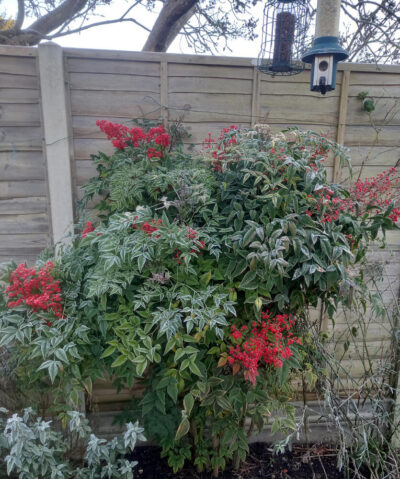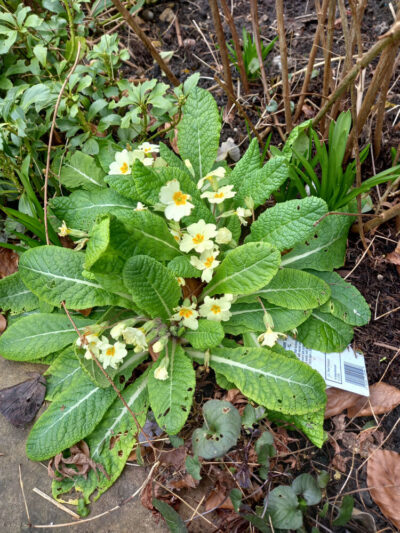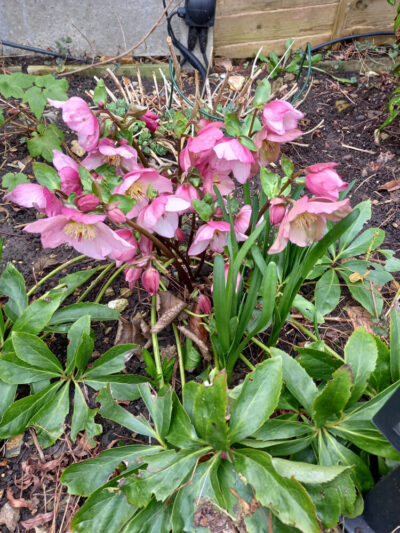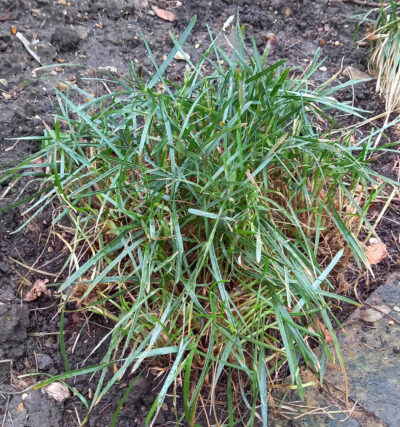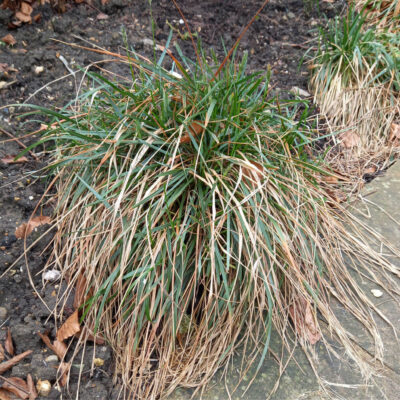What’s looking good at this time of year?
Despite it feeling chilly and grey, there are still some plants giving colour at this time of year. The berries on Nandina give a lovely burst of red against its evergreen foliage, primroses are out with their pastel yellow giving a hint of brightness and hellebores are out in all their glory.
- Nandina
- Primrose
- Helebore
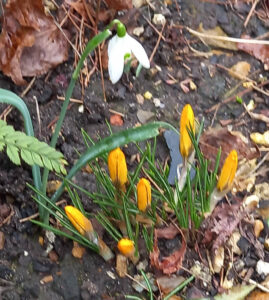 As well as these, there are a number of bulbs showing themselves through the earth, snowdrops and crocuses already being out, with early daffodils sprouting in earnest.
As well as these, there are a number of bulbs showing themselves through the earth, snowdrops and crocuses already being out, with early daffodils sprouting in earnest.
Ornamental grasses are also adding to the picture in the garden. The deciduous grasses like the Panicum in the photo below are still upright, giving texture and form. When the new green shoots start to appear, probably sometime in March, will be the time to cut them back allowing the new years’ growth to come through.
It’s also time to give your evergreen grasses a ‘comb’ – the photos below show a Luzula before and after its tidy up.
Birds
The birds in the garden love berries and seed heads, but still appreciate a bit extra in their diet, so make sure your feeders are kept clean and topped up, as they’re feeding like mad on the seed mix in our garden.
Allotment/ Veg patch
Although it might feel a bit early in the year there are a few jobs you can be doing for your veg patch or allotment. Now’s the time to get your seed potatoes going – known as ‘chitting’. It’s simply putting them in a seed tray or egg box, somewhere light and frost free, with their ‘eyes’ uppermost, which will start them sprouting, ready to plant in March or April, when they have reached about 2cm in length.
You can also be preparing seed beds, so they’re ready for when the weather and soil warms up; protect any fruit buds from frost with fleece and get your frames and netting in place, ready to protect and fruit and veg that are a temptation for hungry birds as they start to show.
Pruning
Now is the right time for a number of shrubs to be pruned – Abelia, Callistemon, mid and late flowering Clematis, Cotoneaster, shrub Roses, deciduous Viburnum and the last chance for Sambucus.
As well as the last chance for Sambucus it’s also the last chance for one of the two Wisteria pruning times.
Now that the plant is dormant and leafless, cut back the shoots you pruned in summer to two or three buds, to tidy up the plant before the growing season starts. This also ensures the flowers won’t be hidden by leaves.
How to hard prune or renovate wisteria
If you have an old plant that needs a hard prune or a bit of a renovation now’s the time. You can remove old, worn-out growth, or branches growing over windows or protruding outwards from the face of the building.
You may need to drastically shorten long branches, remove sections of older stems to just above a strong young branch, or cutting completely back to a main branch, or even to ground level. Take your time if you need to remove larger, thicker branches or ones that are twining round others as you may need to trace them back before removing the. The end result should be a frame work of reasonably well-spaced branches.
Other points to consider when hard pruning;
- Hard pruning will stimulate strong, new growth so it is better to avoid feeding in the first spring after hard pruning
- If there are gaps in the framework suitably positioned new growths can be trained in, with flowering usually resuming in two or three years’ time.
It’s also a good time to check any structures that you’ve got climbers growing up before they start shooting up in the Spring. It’s much easier to carry out that check now and effect any repairs that are needed so they’re all in good shape for later in the year.
Moving, dividing & planting
Now’s the time to move any deciduous shrubs that you may feel are in the wrong place, provided the ground is not frozen or waterlogged.
You can also divide clumps of herbaceous perennials – there are a few reasons you might want to do this;
- They’ve outgrown their space
- They’re not flowering very well
- You want to use to get some extra plants
It’s also a good time to plant hedging, shrubs, trees and climbers as they’ll have time to set their roots before they want to start putting on top growth. Roses too can be planted now, as bare root ones are available and cheaper than potted ones. Just remember not to plant them where they’ve been before, as they can suffer from replant diseases.
Make a new pond
The final job in this months’ offering you may fancy, is to dig a new pond, perhaps with an adjacent bog garden – the spring rains should help to fill it. I’d recommend a minimum depth of 60cm (2ft) at the deepest point, to reduce the risk of the pond freezing to its full depth. Gently sloping contours between the shallow and deep areas, and between the bank and the water, are more wildlife-friendly, and help to make marginal plantings appear natural. A pebble beach will also aid wildlife getting in and out of the pond, particularly frogs, toads and newts.

